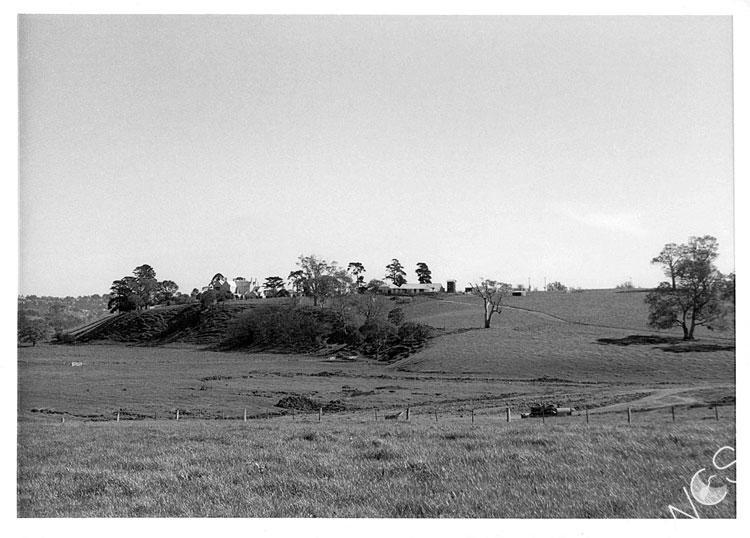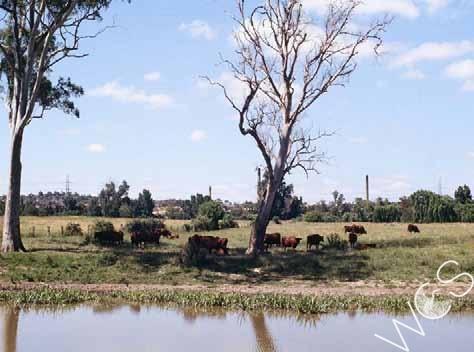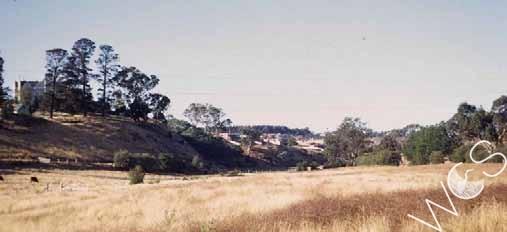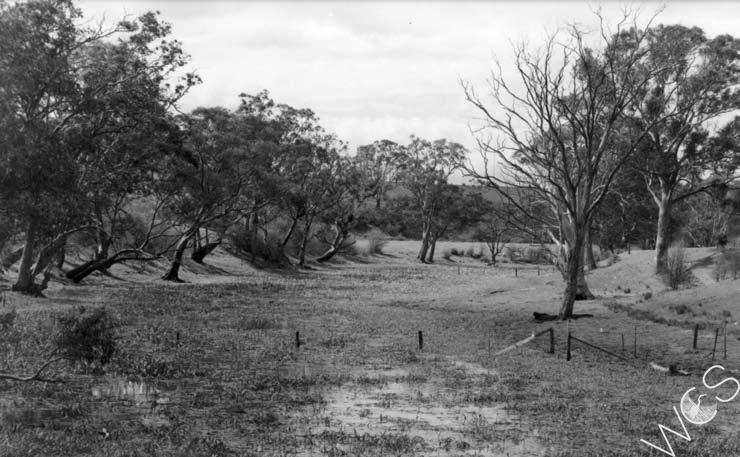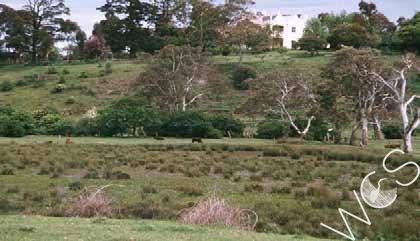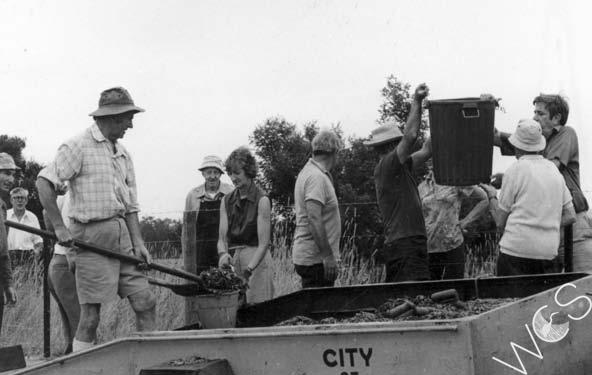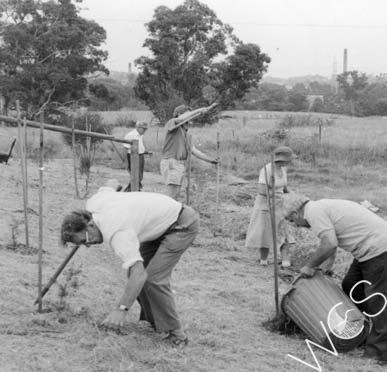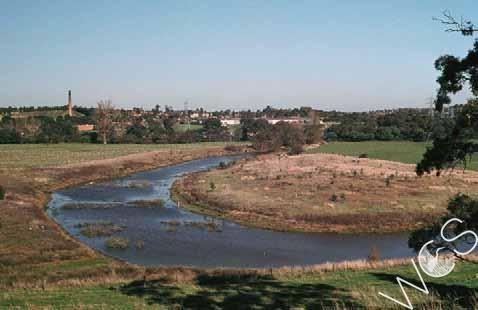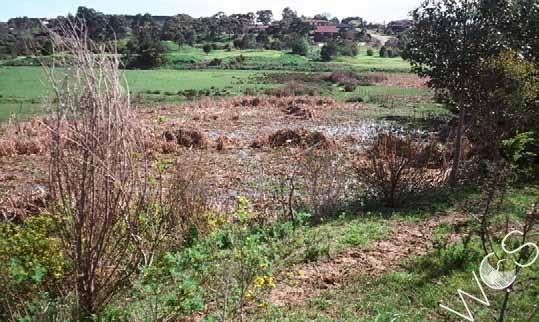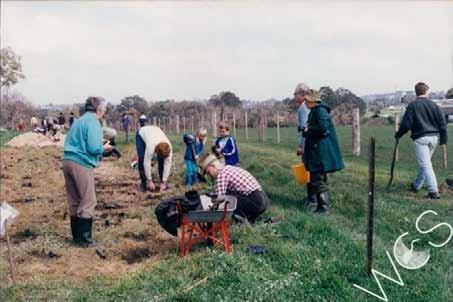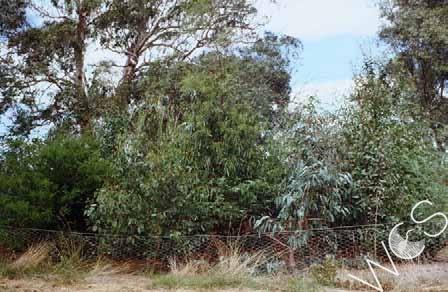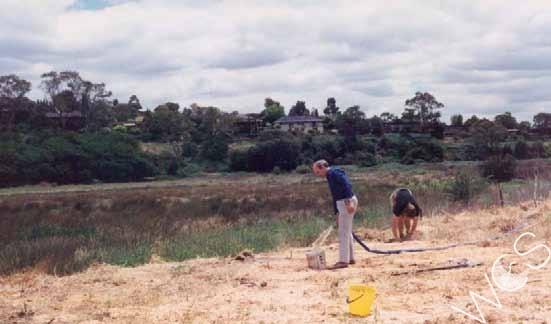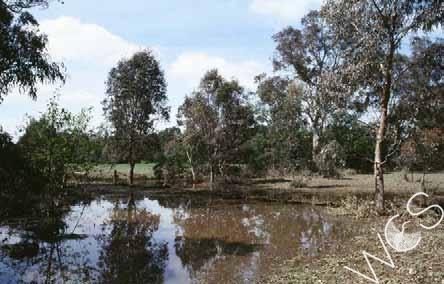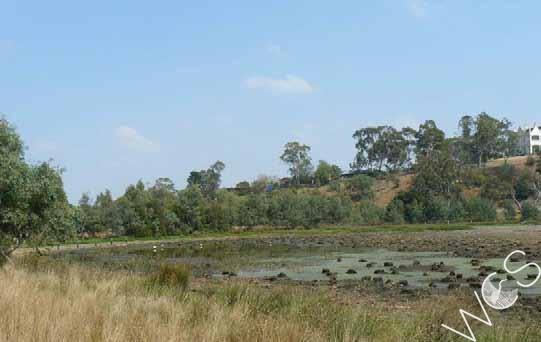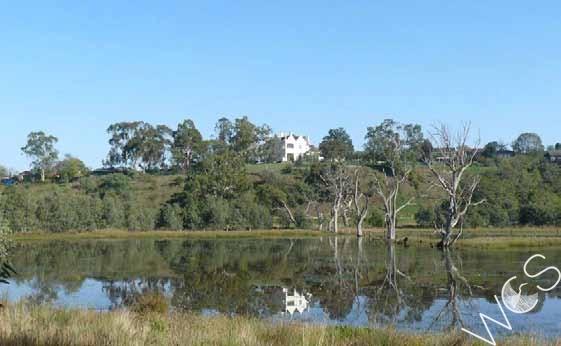Warringal Conservation Society was founded in 1970 out of a need to save Banyule Flats and Warringal Parklands from pressures of development. These tranquil natural areas were being threatened by sporting ovals with attendant unnatural night lighting, and there was a strong community response to form a society to advocate for wildlife and the environment.
The Society is one of the oldest environmental friends groups in Victoria with members from all walks of life; we recommend that you read this History (link) compiled by long-time member Anthea Fleming.
The Banyule Wetlands are now recognised as a Wetland Area of State Significance, but in the late 1960s they were threatened with being drained and filled to develop sportsfields and a basketball stadium.
Banyule Flats. 1963. (Click to view all images in a slideshow)
Banyule Flats lay in a farmland setting until the 1960s, when the estate surrounding Banyule House was sub-divided for housing. About that time, Heidelberg City Council acquired the Reserve area, intending to convert much of it into sportsfields. Meantime, the land was leased back to the vendor, Mr Alan Baxter, who continued to graze his Red Poll cattle, breeding herd bulls. The land to the east, now managed by Melbourne Parks, was a dairy farm. The Friesian bull was a hazard to bird watchers.
Red Poll cattle at Banyule Billabong, summer 1980. (Photo by A.M.Fleming.) Note absence of undergrowth and trampled shoreline. Taken from south end of Somerset Drive car-park.
Reg Johnson 1969 - Banyule Valley looking north
Community concern about the fate of the wetlands was one factor which led to the foundation of Warringal Conservation Society in August 1970. Several founding members, including Reg Johnson and Howard Jarman, knew the area well from birdwatching there with the Bird Observers
Club (now BOCA). The Banyule Billabong was the main focus. It was then a large open stretch of water, full of water birds when full, with scattered large River Red Gums and one or two Swamp Gums on its banks. Cattle had eaten out almost all other indigenous plants. Hawthorns and blackberries provided some cover for small birds, and some wattles and other shrubs survived with the gums on the Yarra banks. From Banyule House on the scarp, the Billabong was far more conspicuous than the Yarra and was often mistaken for it. Some paddocks were cut for hay; long grass was habitat for Stubble Quail, Skylarks and Rufous Songlarks. Weedy clumps among the grass sheltered Golden-headed Cisticolas. In drought years, when billabongs and other wetlands dried out, farmers might take the opportunity to plant a potato crop on the rich soil.
Banyule Billabong in 1970s – nearly dry. (Probably taken by Derry Sargent)
Banyule Creek had been diverted in farming days in an attempt to drain the Banyule Swamp, south of Banyule Road. There were some beds of Common Reed and Cumbungi (Typha), but most of the area was Meadow Swampland with many sedge tussocks – ideal habitat for migrant Latham's Snipe. The Swamp was also a breeding area for waterbirds. Snakes and frogs were numerous, including the Growling Grass Frog, which is probably now locally extinct.
From its foundation in 1970, Warringal Conservation Society lobbied very actively to preserve the Banyule Flats. In the event, Heidelberg Council constructed only two of the four projected ovals, c.1972-3, and retained the rest of the Wetland area – one of the first two of Melbourne municipalities to preserve a wetland for its conservation values (Sandringham City Council was the other). The Banyule Native Garden (designed by Peter Glass) was accepted in principle – the original plan had been for ornamental fruit trees such as plums and flowering crab-apples. It began as a demonstration of the suitability of Australian plants for gardens, and many ornamental non-indigenous plants were established. Several plants were stolen, presumably by people who believed in this principle. Construction of the viewing mound began in 1972.
From May 1971, WCS members carried out botanical surveys in the area and in other Yarra Valley wetlands, and prepared a plan and scale model for the eventual development of the area as a nature reserve - including walking tracks with stiles over the fences for public access. Many of these suggestions were in fact carried out. [See Banyule 1972 document].
The first WCS plantings were made in September 1974 behind the houses in Somerset Drive, to screen their rear fences from the Reserve. The Mayor Bill Foster took part and photographs appeared in The Heidelberger. Follow-up plantings took place in April 1975 and June 1976, replacing those which had not survived. Many of the plants (mainly ornamental natives) had been propagated by WCS members.
One WCS suggestion was the buffer bank between the Ovals and the Swamp area. When completed in 1975, this provided both a windbreak for the sportsfields and protection from disturbance for the Swamp's wildlife. The material used was a mixture of clay and broken footpaths and concrete.
During the spring and summer of 1978 and '79, the Bird Observers Club carried out a survey of Latham's Snipe in the area. More than 100 Snipe were seen. Several WCS members participated. At this time the valley floor was divided by fences into paddocks and used for cattle grazing. Sedge and rush tussocks remained ungrazed, but reedbeds and Typha were mainly confined to the eastern side near the Ovals, and to the drainlines. The main wetland area lay at the southern end and was fairly shallow. Water Ribbons provided food and cover for ducks and other birds, and Black Swans sometimes nested there in the winter. A dense reed swamp stood in the creek and drainage lines in the north of the valley.
Banyule Swamp 1984 Reg Johnson photo. Note row of Red Gums to right which have since died. This area now flooded.
In December 1980, Heidelberg Council allocated $5000 for plantings on the west side of the ovals' Buffer Bank. An early Council planting took place soon after. Plants were watered in and needed more water over a dry summer. WCS carried out a Maintenance Working Bee on 31 January 1981, with Council support, weeding and mulching. The weather was very hot; work started at 7.00 am. Ward Councillors Brown and Hec Davis attended.
Unloading mulch Jan 1981. Photo by Derry Sargent. L to R: Keith Holywell (Pres.WCS), Gavin Baird, obscure, Brian Ekers with shovel, Jack Wright, ?Mrs Sargent, Cr.. Hec Davis, Howard Jarman and Gary Griffin lifting bin, two unknowns.
Spreading mulch Jan 1981. Photo by Derry Sargent. Reg Johnson and Cr Hec Davis in foreground. Gavin Baird, Gary Griffin and Anthea Fleming behind.
In 1980, the Yarra Valley Park was established, under the Melbourne Metropolitan Board of Works Metropolitan Parks program. At Banyule, this covered nearly all the land east of the carpark; the boundary is still marked by a ditch. The dairy herd was replaced for a few years by a few Angus steers. The Billabong's eastern margins and the riverbanks were carefully fenced from the remaining cattle. The difference between management of the MMBW land and the heavily grazed area owned by HCC soon became apparent [see photo]. In 1984, clumps of Blackberry, Boxthorn and Hawthorn were removed from the Viewbank Hill scarp, but it would be some years before it was open to the public.
Banyule Billabong seen from Viewbank Hill, 1985 Photo A.M. Fleming. MMBW part of Billabong has been fenced from cattle. HCC land is green area to right.
In the summer of 1980-81, the Banyule Billabong was almost dry, following a drought. Following representations from members of both WCS and the BOC, the MMBW pumped in water from the Yarra to re-fill it. It was immediately re-populated by water-birds. In winter 1981, (7th June), WCS members re-planted the whole length of the Buffer Bank for World Environment Day, with HCC support. Despite unpromising soil, a good windbreak was developed, though not all the shrubs and trees were locally indigenous. The plants were watered in, but not subsequently watered. During the planting, volunteers could watch Black Swans on their nest in the Swamp, and were observed themselves by Flame Robins (a winter migrant which has since become quite uncommon).
During winter 1983, WCS assisted with a planting bee in the Banyule Native Garden, which had suffered badly from neglect. Some plants were lost through careless mowing, others buried under excessive layers of mulch, and weeds were taking over.
Banyule Swamp in spring 1984 -trampled and grazed by cattle. Photo by Reg Johnson
The reed-beds next to the northern Oval suffered in spring 1984, when the Red Poll cattle broke down a fence and grazed and trampled them – they also trespassed on the Oval. When WCS members inspected this, they saw newly-returned migrant Reed Warblers flying over the damaged area, searching in vain for their former nest-sites. It was several years before they returned, in reduced numbers. Following this, HCC staff investigated the lease terms and found that the boundaries had never been definitely established. Fencing in the Wetland area was subsequently improved, but the Billabong margins were not securely fenced until 1989.
(Of course WCS activities were not confined to Banyule Flats – WCS members also took part in plantings at Warringal Swamp and Wilson Reserve, and the results of a 1983 planting at Yarra Flats proved conclusively that plants propagated from locally collected seeds and cuttings far out-performed the then-available commercial stock.) In Sept. 1986, a stand of young Red Gums was planted near the Billabong's elm clump on the MMBW land, then known as Banyule Sanctuary. Some were later lost to trespassing cattle.
In 1987, after consultation with WCS, the Council re-aligned the Banyule Flats walking-tracks. Stiles were changed for bollards, and fences separated human and cattle traffic. The northern footbridge over Banyule Creek was replaced – it had been washed away in a flood some years before. Next year, in 1988, WCS held weeding and planting bees on the challenging terrain of the scarp below Banyule House.
A 1990 description of Banyule Flats
From Sid Cowling, “Explore Melbourne's Wetlands”, National Trust Victoria, 1991 – pp 21-22
Banyule Flats contains a series of wetlands, including reed-swamps, a shallow herb and sedge marsh, and a billabong of the Yarra River, together with sporting fields, a native bush garden and grazing paddocks.
Water: The Banyule Flats swamps are flooded to less than one metre in winter and are often dry by summer. The billabong contains water at all times.
Vegetation: The deep swamp and drainage lines have dense reeds. The shallow areas have herbs, grasses and sedges under dead and old gum trees, and the billabong has old gum
trees along its banks. Some of the paddocks are grazed, whilst other areas are rank grassland with clumps of blackberry and boxthorn.
Cowling's description was soon to be out of date. The margins of the Billabong were by 2003 densely covered with indigenous trees and shrubs. These derive from a major WCS project, carried out in 1989 through 1992, to restore the Billabong to more natural conditions, under the leadership of our then President Vic Marks. This was possible because HCC had at last fenced the Billabong margins from the cattle.This project was supported and assisted by Heidelberg Council, which made a grant of $2500 towards the cost of plants from an indigenous nursery.
It was decided to carry out a 'Megaplanting' in September, and to establish mixed clumps of plants at intervals around the top of the banks. Volunteers were invited from other conservation bodies – the Tree Project, The Commission for the Future, and Riverlands Conservation Society. The sites were prepared by weed and grass suppression. (At first it was proposed to use donated carpet as weed mat, but this was stolen from the site.) In the end HCC staff sprayed each site with weedkiller. On Sunday 3rd September, more than 100 volunteers arrived, and succeeded in planting 4500 plants in nine clumps, each of about 16 m. radius. A barbecue lunch was provided by Ivanhoe Sea Venturers. Each clump was protected from the numerous rabbits by a fence of wire netting and star pickets (much more economical than individual tree-guards.)
Megaplanting Sept 1989 on banks of Banyule Billabong. (Photo B.R.Fleming) Beryl Jarman collecting plant tubes left. Anthea Fleming with bucket right; Ian Leith behind her.
In subsequent years WCS members carried out weeding bees in these clumps and observed their rapid growth. Kangaroo Apples were among the first plants to increase by natural regeneration. Later infill plantings filled the gaps between the original plantings. In the early years, there was still occasional trouble with the cattle, when they found their way into the clumps and browsed there. Yarra Valley Parks reported significant improvement in the Billabong's water quality, after the cattle were fenced off from its margins.
1991 - Megaplanting clump – all made excellent growth (Photo A.M. Fleming)
On 1st November 1991, the Yarra Trail opened from Banksia Street to Eltham. At first, cyclists and walkers crossed the paddocks directly between Plymouth St and the Somerset Drive car-park. Following discussions involving WCS and other bodies, the present Cycle and Walking Trail, was built in 1993, passing round the Wetland via the Native Garden area (now the Banyule Flats Conservation Zone). The path follows the Buffer Bank plantings on the west side of the Ovals to the car-park. This coincided with a WCS planting on the East Bank of the Wetland, on a site formerly used as a tip. This November planting was followed by a heat-wave, and emergency watering was necessary to save the young plants. Later they were almost engulfed by pasture weeds, such as Paterson's Curse. Vigorous weeding was followed with a layer of mulch. Wattles and melaleucas were established, with some Red Gums. Subsequent WCS plantings in this area used a motor-pump for watering and prepared sites more effectively with weeding and mulch.
Motor pump obtains water from Swamp, Geoff Baker fills bucket . (Reg Johnson photo)
In 1993, WCS carried out no plantings at Banyule Flats, but worked at Warringal Swamp instead. However members took part in planning for a Wetland Education Centre which was intended by Banyule High School. These very promising plans were aborted when the school was closed in December 1993. This decision was made by the Kennett LCP State Government, which also brought in major changes to Victorian municipalities. The City of Heidelberg came to an end, to be replaced by appointed Commissioners between December 1994 and March 1997. Watsonia and Greensborough Cities were merged with Heidelberg as the new City of Banyule.
Banyule Flats in Drought - 1998 - 2003
After failure of the winter rains, Banyule Billabong dried out completely in 1998. Carp died in the last puddles. At first the bottom was dried cracked mud, but it was soon colonized by grasses. These were followed by a great growth of young wattles and seedling River Red Gums, in the absence of grazing fauna. Seeds germinated well in the autumn rain in 1999. At times it has received a little rain from showers and run-off, and temporary shallow water made a splendid safe breeding area for ducks and other water-birds in spring 2001. But since then, it has remained dry for most of the time, and is now densely overgrown.
Banyule City Council extended the Banyule Swamp by blocking its outlet drain in March 1999. Fortuitously, it was filled by sudden heavy autumn rain. It was promptly colonized by many ducks and a pair of Black Swans which nested and reared five cygnets. They were very popular with visitors. It became necessary for BCC to put up a notice to discourage people from feeding bread to the birds. Among other visitors were Black-necked Stilts (which bred successfully) and migrant Sharp-tailed Sandpipers which joined the Latham's Snipe to feed on the margins – probably the first for 30 years (The Sandpipers did not re-appear, probably because the open mud was so quickly colonized by weeds and grasses).
One unforeseen effect was the loss of sedge and herb vegetation from the now permanently flooded area. During January-March 2003, the Swamp was reduced to a few very shallow pools. Snipe were easily observed feeding on the mud, but ducks and swans deserted the area.
In Spring 2001, an Australian Painted Snipe was discovered by BOCA members, at a settling pond at the northeast corner of the Swamp, where a major drain enters. This rarity attracted birdwatchers from all over Melbourne and even interstate to the 'Grubby Pool'. Painted Snipe are a rare and vulnerable species, seldom seen by most birdwatchers. It was a remarkably well-camouflaged immature female, which gradually acquired more adult plumage during its stay of about two months.
The native mammal fauna has increased in recent years, probably as a result of the drought – a small population of Eastern Grey Kangaroos is now resident, as are Wombats. Swamp Wallabies and occasional Koalas have been recorded. So have Echidnas. A control program has reduced rabbit numbers (but needs to be continued) and a Hare has been seen in the south paddock. The area continues to attract interesting birds, with the Powerful Owl and Owlet-Nightjar seen from time to time. Tawny Frogmouths breed every year. Unfortunately raptors now seem uncommon, and winter Flame Robins have disappeared almost completely, as have Rufous and Brown Songlarks, Stubble Quail and Skylarks, which need long grass and open paddocks.
In Autumn 2003 the Swamp refilled after rain. Since then it has continued a cycle of alternate wet and dry conditions, depending on rain and local run-off. In November 2003 and January 2004, two sudden storms briefly refilled the Billabong, and flooded much of the Yarra Valley parks – but since then there have been no further flood episodes. Current management relies on letting nature take its course, and the prolonged drought and consequent severe water shortages make it unlikely that the Billabong will be artificially filled. Water-logging would kill the wattles, but some Red Gums would survive.
Feb.2004 – Banyule Billabong briefly re-filled by cloudburst (Photo Anthea Fleming).
In the terrible summer of 2009, the drought conditions were extreme and the Swamp dried almost completely.
Banyule Swamp, 22 Feb 2009, drying out. White Ibis feed in shallows. (Photo A.M.Fleming)
Fortunately storms followed the Black Saturday Bushfires and the Swamp filled again. Soon healthy growths of Water Ribbons and other plants broke the reflections and provided food for waterlife and birds.
Banyule House reflected in Swamp, Easter 2009 (Photo A.M.Fleming)
What Banyule Flats' future will be we cannot tell. The threat of major Freeway developments through the area, linking the Greensborough Highway and Eastern Freeway, is a continuing and major source of concern.
©A.M. Fleming 2003, updated Jan. 2009 and July 2010.

